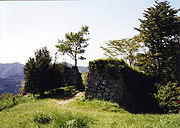
Tsuwano Domain
Encyclopedia

Han (Japan)
The or domain was the name of the estate belonging to a warrior in Japan after the 17th century. The fiefs of the daimyos of the samurai class of Japan during the Edo period were called han.-Edo period:...
of the Edo period
Edo period
The , or , is a division of Japanese history which was ruled by the shoguns of the Tokugawa family, running from 1603 to 1868. The political entity of this period was the Tokugawa shogunate....
, located in Iwami Province
Iwami Province
was an old province of Japan in the area that is today the western part of Shimane Prefecture. It was sometimes called . Iwami bordered Aki, Bingo, Izumo, Nagato, and Suō provinces.In the Heian era the capital was at modern-day Hamada....
(modern-day Tsuwano, Shimane
Tsuwano, Shimane
is a town in Kanoashi District, Shimane Prefecture, Japan. As of 2003, the town has an estimated population of 8,878 and a density of 28.9 persons per km². The total area is 307.09 km²....
). The Meiji-era author Mori Ōgai
Mori Ogai
was a Japanese physician, translator, novelist and poet. is considered his major work.- Early life :Mori was born as Mori Rintarō in Tsuwano, Iwami province . His family were hereditary physicians to the daimyō of the Tsuwano Domain...
was the son of a Tsuwano retainer.
List of Daimyo
- Sakazaki clan (TozamaTozamaA ' was a daimyo who was considered an outsider by the rulers of Japan. The term came into use in the Kamakura period and continued until the end of the Edo period.-Edo period:...
; 30,000->43,468 kokuKokuThe is a Japanese unit of volume, equal to ten cubic shaku. In this definition, 3.5937 koku equal one cubic metre, i.e. 1 koku is approximately 278.3 litres. The koku was originally defined as a quantity of rice, historically defined as enough rice to feed one person for one year...
)
- Sakazaki NaomoriSakazaki Naomori' was a Japanese daimyo of the early Edo period, who served as lord of the Tsuwano Domain.Originally from Joseon, Sakazaki helped Japanese army during the Japanese invasions of Korea. He became a confidant of Ukita Hideie...
- Kamei clan (TozamaTozamaA ' was a daimyo who was considered an outsider by the rulers of Japan. The term came into use in the Kamakura period and continued until the end of the Edo period.-Edo period:...
; 43,000 kokuKokuThe is a Japanese unit of volume, equal to ten cubic shaku. In this definition, 3.5937 koku equal one cubic metre, i.e. 1 koku is approximately 278.3 litres. The koku was originally defined as a quantity of rice, historically defined as enough rice to feed one person for one year...
)
- Kamei MasanoriKamei Masanoriwas a Japanese daimyo of the early Edo period, who ruled the Tsuwano Domain. His early service began under Tokugawa Ieyasu in 1602, and in 1604 he was assigned as an attendant to Ieyasu's son Hidetada. Upon the death of his father, he received the fief of Shikano, and was transferred to Tsuwano...
- Kamei KoremasaKamei Koremasawas a Japanese daimyo of the early Edo period, who ruled the Tsuwano Domain. He assisted in the construction of a part of Kōdaiji Temple in Kyoto.-References:...
- Kamei Korechika
- Kamei Koremitsu
- Kamei Korenobu
- Kamei Koretane
- Kamei Norisada
- Kamei Norikata
- Kamei Korenao
- Kamei Korekata
- Kamei Koremi

